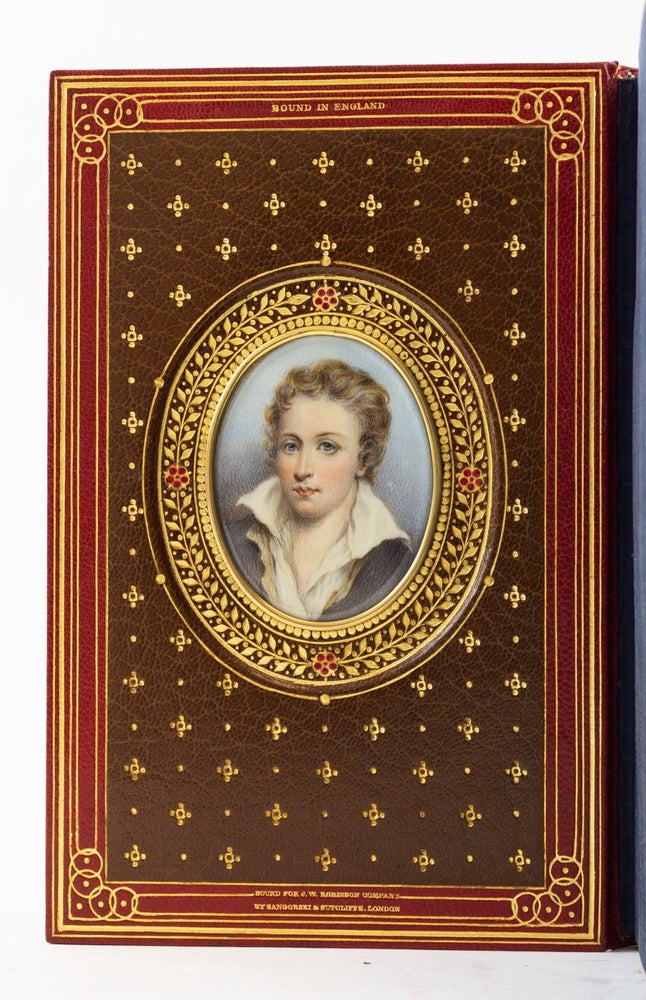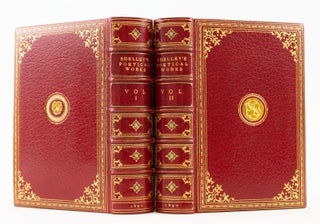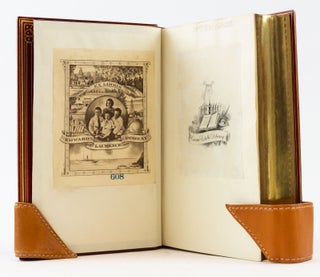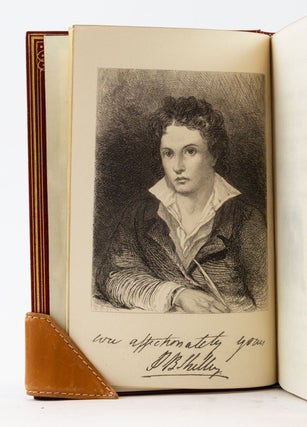THE POETICAL WORKS.
(London: [Printed at the Ballantyne Press for] Reeves & Turner, 1892). 188 x 122 mm. (7 3/8 x 4 3/4"). Two volumes. Edited by H. Buxton Forman. Third Edition with the Notes of Mary Wollstonecraft Shelley.
PARTICULARLY FINE RED CRUSHED MOROCCO, GILT AND ONLAID, BY SANGORSKI & SUTCLIFFE (stamp-signed on front turn-in), covers framed by multiple plain and decorative rolls, cornerpieces with the gilt torch of liberty extending obliquely from an onlaid green morocco heart bracketed by volutes, front boards with central onlaid citron morocco medallion stamped with the poet's gilt monogram, rear boards with onlaid citron morocco pansy surrounded by a gilt collar with the quote "Pansies let my flowers be" (from "Remembrance"); raised bands, spine compartments with onlaid green morocco quatrefoil at center, volutes at corners, volume I with FRONT DOUBLURE OF BROWN MOROCCO semé with rows of alternating quatrefoils and dots, at center A MINIATURE PORTRAIT OF SHELLEY UNDER GLASS framed by a laurel wreath inlaid with four red morocco cinquefoils, navy blue moiré silk endleaves, all edges gilt and delicately gauffered. Housed together in a fleece-lined red cloth drop-back box. Frontispiece in each volume, vignette title pages. Front flyleaves with engraved bookplates of Edward Laurence Doheny and Carrie Estelle Doheny. ◆A FLAWLESS AND SPARKLING SET.
This is the outstanding Doheny copy, in lovely bindings, of a body of literature graced with a lyricism Day asserts is "unmatched elsewhere in English verse in its ethereal, ideal beauty." While the notes of Shelley's wife, appended here, have aroused considerable denigration (she is accused, among other things, of making her husband's verse less political than it actually was), her editorial work is nevertheless professional and has remained an essential source for the study of Shelley's work. As Betty T. Bennett explains, "biographers and critics agree that Mary Shelley's commitment to bring [her husband] the notice she believed his works merited was the single, major force that established Shelley's reputation during a period when he almost certainly would have faded from public view." Thanks to her efforts, Shelley (1792-1822) is one of the best-known English poets and an icon of the Romantic movement. According to DNB, our editor, Henry (Harry) Buxton Forman (1842–1917) "channelled a general enthusiasm into a minute study of textual details, for which his careful and exacting temperament was ideally suited. His patient application produced impressive editions of Shelley," who was, along with Keats, Forman's main literary interest. After studying under and then working for Douglas Cockerell, Francis Sangorski and George Sutcliffe founded their own bindery in 1901 and continued in a successful partnership until 1912, when Francis tragically drowned. Despite this loss, the firm grew and prospered, employing a staff of 80 by the mid-1920s and becoming perhaps the most successful English bindery of the 20th century. The "Cosway" binding, with painted miniatures inlaid in handsome morocco, apparently originated with the London bookselling firm of Henry Sotheran about 1909, the year G. C. Williamson's book entitled "Richard Cosway" was remaindered by Sotheran and presumably given this special decorative treatment. The name "Cosway"--referring to the British miniature painter, Richard Cosway (1742-1821)--was then used to describe any book so treated, whoever its author. This set was bound by Sangorski & Sutcliffe for book dealer J. W. Robinson of Los Angeles, who supplied many books for the superb collection of Estelle Doheny (1875-1958), one of the most distinguished women book collectors of the 20th century, whose magnificent library was especially rich in fine bindings. Volumes from her collection are sought after for their especially fine condition. (ST18713)
Price: $10,000.00




